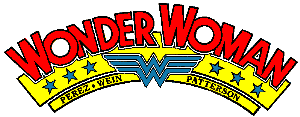
 Wonder Woman
(DC)
Wonder Woman
(DC)vol.2, #1-46* by George Pérez (e-mail), with Len Wein, Mindy Newell, Chris Marrinan, Jill Thompson, Bruce Patterson, Will Blyberg, Romeo Tanghal, etc.
Rating:
*I stopped at #46 because I haven't found #47 and several of the issues that
followed, at least not at good prices. Besides, I figure that reviewing 1000+ pages is
ambitious enough... at least until I get around to reviewing my complete run of
Flash #1-120 (and counting). {grin}
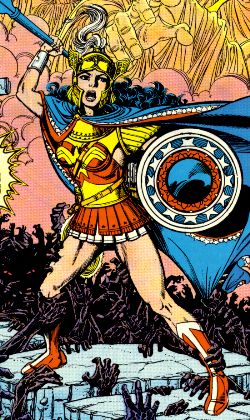
![]() "Ya shoulda been there!" That's what I said to myself as I read the post-Crisis relaunch
of Wonder Woman, a decade after it began. But at the time, I was engrossed in my
studies of computers, alcohol, and the guy down the hall at college, having stopped reading
comics a few years earlier. Just my luck to miss out on one of the most heady periods of
DC's publishing history.
"Ya shoulda been there!" That's what I said to myself as I read the post-Crisis relaunch
of Wonder Woman, a decade after it began. But at the time, I was engrossed in my
studies of computers, alcohol, and the guy down the hall at college, having stopped reading
comics a few years earlier. Just my luck to miss out on one of the most heady periods of
DC's publishing history.
![]() But through the magic of back issues, I've been able to pick up some what I missed... often
at bargain prices. The down side is that some of these copies have not aged gracefully,
with the ink spreading out and bleeding through the pages. {Insert standard plea for paper
better than newsprint, but not that glossy stuff they've been using lately} Why, oh, why
are there two TPBs keeping the recent (and IMHO, inferior) Loebs/Deodato issues in
print, but none of the Pérez issues? (I know: "The coloring process used back then
is outdated." I'd settle for black and white, or "outdated" color on non-glossy paper.)
But through the magic of back issues, I've been able to pick up some what I missed... often
at bargain prices. The down side is that some of these copies have not aged gracefully,
with the ink spreading out and bleeding through the pages. {Insert standard plea for paper
better than newsprint, but not that glossy stuff they've been using lately} Why, oh, why
are there two TPBs keeping the recent (and IMHO, inferior) Loebs/Deodato issues in
print, but none of the Pérez issues? (I know: "The coloring process used back then
is outdated." I'd settle for black and white, or "outdated" color on non-glossy paper.)
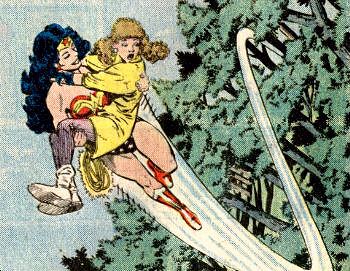
|
| Diana and Vanessa in #8, pencils by Pérez; inks by Patterson |
![]() Pérez' art (with Bruce Patterson inking) was beautiful. I was especially impressed
with his ability to draw such different faces and body types, especially in a book
with so many female characters. Diana, Julia Kapetelis, Vanessa Kapetelis, Etta Candy,
Myndi Mayer, the various goddesses... all distinct, all looking their respective ages
(except the Amazons and goddesses, of course). By contrast, the women in the Deodato-drawn
Wonder Woman #0 I bought were nearly indistinguishable except for their hair and the
accessories they wore with their nipple covers and g-strings. Pérez' men were
equally varied: middle-aged Steve Trevor, beefy Heracles, fleet-footed Hermes, teen
heartthrob Barry Locatelli, etc. The fact that Diana wore different clothing (including
battle-armor and classical Greek versions of her costume, as well as the proverbial
turtleneck sweater) also impressed me. After all, even feminist women like to change their
outfits from time to time. {grin}.
Pérez' art (with Bruce Patterson inking) was beautiful. I was especially impressed
with his ability to draw such different faces and body types, especially in a book
with so many female characters. Diana, Julia Kapetelis, Vanessa Kapetelis, Etta Candy,
Myndi Mayer, the various goddesses... all distinct, all looking their respective ages
(except the Amazons and goddesses, of course). By contrast, the women in the Deodato-drawn
Wonder Woman #0 I bought were nearly indistinguishable except for their hair and the
accessories they wore with their nipple covers and g-strings. Pérez' men were
equally varied: middle-aged Steve Trevor, beefy Heracles, fleet-footed Hermes, teen
heartthrob Barry Locatelli, etc. The fact that Diana wore different clothing (including
battle-armor and classical Greek versions of her costume, as well as the proverbial
turtleneck sweater) also impressed me. After all, even feminist women like to change their
outfits from time to time. {grin}.
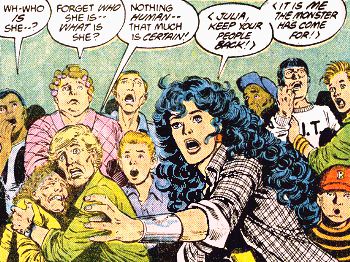
|
| Diana prepares to fight Decay in #4, pencils by Pérez; inks by Patterson |
![]() Pérez cut back on the writing a year after he stopped drawing, continuing to plot
the stories, but leaving the scripting to Mindy Newell. (He had similar assistance from
Len Wein for the first year.) The impact of this wasn't as noticeable. In fact, I found #46
to be more powerful and moving than many of the early Wein- or Pérez-scripted
issues. I think there was a more noticeable decline in the stories when Pérez
stopped drawing them, than when he stopped scripting. I think the switch from
writing for himself to writing for another artist diminished his emotional involvement in
the series a bit.
Pérez cut back on the writing a year after he stopped drawing, continuing to plot
the stories, but leaving the scripting to Mindy Newell. (He had similar assistance from
Len Wein for the first year.) The impact of this wasn't as noticeable. In fact, I found #46
to be more powerful and moving than many of the early Wein- or Pérez-scripted
issues. I think there was a more noticeable decline in the stories when Pérez
stopped drawing them, than when he stopped scripting. I think the switch from
writing for himself to writing for another artist diminished his emotional involvement in
the series a bit.
![]() But when Pérez was "on", he was very "on". The storyline that launched the
series had an epic flavor that successfully caught the spirit of the ancient myths as
recorded by Hesiod. Kirby fans can have their New Gods; I'll take the original,
as interpreted, updated, and extended by Pérez as the source for my
"modern myths". The Greek gods were a special interest of mine in high school. I did
character designs and basic plotting for what I intended to be the "sequel" to those
stories (before turning my attention to the aforementioned computers, alcohol, and
dorm-mates). And it's clear to me that Pérez did lots of research...
probably even better than mine.
But when Pérez was "on", he was very "on". The storyline that launched the
series had an epic flavor that successfully caught the spirit of the ancient myths as
recorded by Hesiod. Kirby fans can have their New Gods; I'll take the original,
as interpreted, updated, and extended by Pérez as the source for my
"modern myths". The Greek gods were a special interest of mine in high school. I did
character designs and basic plotting for what I intended to be the "sequel" to those
stories (before turning my attention to the aforementioned computers, alcohol, and
dorm-mates). And it's clear to me that Pérez did lots of research...
probably even better than mine.
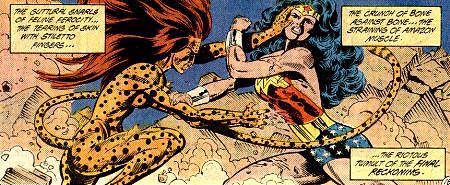
|
| Wonder Woman vs. the Cheetah in #31, pencils by Marrinan; inks by Blyberg |
![]() Of course, the post-Crisis DCU was riddled with Major Crossovers involving lots of
"superhero" situations, but Pérez managed to work them into the series with minimal
pain. I picked up no crossover or tie-in books when I read this series, and except
for missing the "encounter" between Diana and Superman in Action #600, I didn't feel like
I'd been cheated out of a complete story. The "Millennium" crossover required the writers
to retcon disguised Manhunters into their books. Pérez' retcon wasn't at all
plausible, but I don't consider that his fault... it was a lame idea. And if you could
accept it, it became a rather effective element concluding his "Challenge of the Gods"
storyline.
Of course, the post-Crisis DCU was riddled with Major Crossovers involving lots of
"superhero" situations, but Pérez managed to work them into the series with minimal
pain. I picked up no crossover or tie-in books when I read this series, and except
for missing the "encounter" between Diana and Superman in Action #600, I didn't feel like
I'd been cheated out of a complete story. The "Millennium" crossover required the writers
to retcon disguised Manhunters into their books. Pérez' retcon wasn't at all
plausible, but I don't consider that his fault... it was a lame idea. And if you could
accept it, it became a rather effective element concluding his "Challenge of the Gods"
storyline.
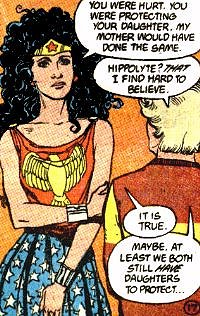
|
| #46, art by Thompson and Tanghal |
![]() And Pérez didn't just use the supporting cast; he developed them.
He showed the relationship between Diana and Julia grow and change. We saw Vanessa
struggle through adolescence, both socially and biologically. We watched Hermes' attempts
to live as a god among mortals, and saw the effect on his unwilling roommate, Steve Trevor.
(Compared to his prominence at times pre-Crisis, Trevor gets limited exposure, but he's
still more complex than the old Trevor usually was.) The villains (including the ones I
didn't care for) had comprehensible motivations, not just maniacal plans for world
domination. Even when Pérez killed a character, they generally stayed dead, but
gained new depth in the process... and the impact on the rest of the cast was carefully
explored.
And Pérez didn't just use the supporting cast; he developed them.
He showed the relationship between Diana and Julia grow and change. We saw Vanessa
struggle through adolescence, both socially and biologically. We watched Hermes' attempts
to live as a god among mortals, and saw the effect on his unwilling roommate, Steve Trevor.
(Compared to his prominence at times pre-Crisis, Trevor gets limited exposure, but he's
still more complex than the old Trevor usually was.) The villains (including the ones I
didn't care for) had comprehensible motivations, not just maniacal plans for world
domination. Even when Pérez killed a character, they generally stayed dead, but
gained new depth in the process... and the impact on the rest of the cast was carefully
explored.
![]() It was definitely worth my while tracking down these four years' worth of comics. But
reading them several years after the fact was a bit bittersweet... knowing that Wein and
Patterson would leave, that Pérez would stop drawing and scripting, that later
the series would be taken over by William Messner-Loebs (whose writing on Wonder Woman
I haven't read enough of to comment meaningfully on) and Mike Deodato (whose typical drawing
style I despise), and that John Byrne would eventually take over and do it his way
instead... in other words, knowing that it wouldn't last.
It was definitely worth my while tracking down these four years' worth of comics. But
reading them several years after the fact was a bit bittersweet... knowing that Wein and
Patterson would leave, that Pérez would stop drawing and scripting, that later
the series would be taken over by William Messner-Loebs (whose writing on Wonder Woman
I haven't read enough of to comment meaningfully on) and Mike Deodato (whose typical drawing
style I despise), and that John Byrne would eventually take over and do it his way
instead... in other words, knowing that it wouldn't last.
![]() But I still have another year or so of Pérez stories to track down, and (assuming I
find Loebs' writing palatable) a bit longer before Deodato kills the series (for me). And
I still have the first 46 issues to reread... as long as the old newsprint holds out.
But I still have another year or so of Pérez stories to track down, and (assuming I
find Loebs' writing palatable) a bit longer before Deodato kills the series (for me). And
I still have the first 46 issues to reread... as long as the old newsprint holds out.
![]()
© Todd VerBeek, Radio ZeroTM